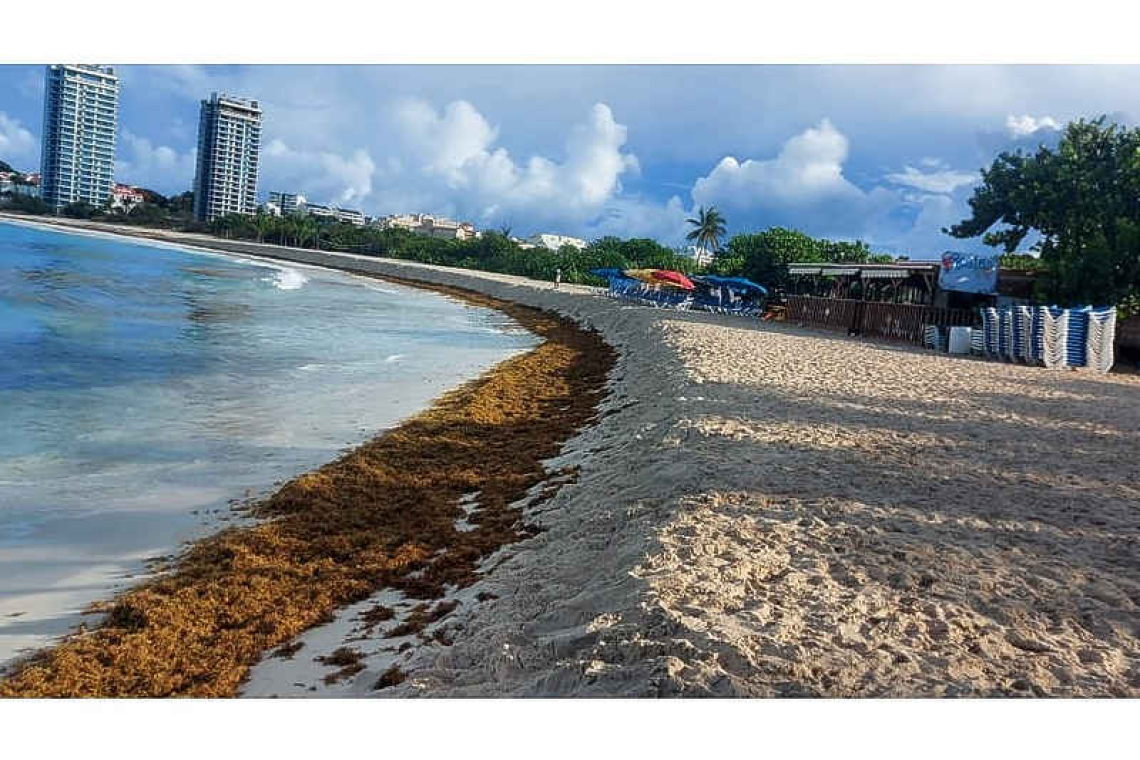Pictured: Sargassum at Mullet Bay.
By Nature Foundation St. Maarten
Have you been to the beach lately? Depending on which beach on the island you like to go to, you may have been surprised by the dark reddish brown, curly, grassy looking mat in the water or on the shore of the beach. It is called Sargassum; and in the past years, we have been getting more and more of it from the sea and on our beautiful beaches. Last July, there was so much Sargassum at the little pier to Pinel island, that no one was able to visit the little island! The Sargassum problem is not only a St. Maarten thing; other islands in the Caribbean and other parts of the world also have been getting tons of it.
What is it?
Sargassum is a species of brown algae. There are two species commonly found in the Caribbean: the Sargassum Natans and Fluitans. Both types look almost exactly the same to the untrained eye. It is free-floating seaweed that does not stick to the ocean floor; it moves around and travels very far with the currents of the ocean.
Sargassum and seagrasses are not the same thing, they are totally different kinds of living organisms. Seagrasses are plants with seeds, flowers and fruits (yes, underwater flowers and fruits); while Sargassum is an alga.
Some people believe that Sargassum makes them itchy, but this is not really true! However, some tiny organisms that live in the Sargassum may cause a reaction or a rash, this does not come from the alga itself, but from its passengers!
Causes
Scientists suggest that the influx of Sargassum in the Caribbean is due to climate change and our water temperatures rising.
There are several theories and ideas from scientists around the world about where Sargassum comes from and why it is spreading so quickly. But because this problem has arisen quickly (within the past five years or so), new information is constantly being uncovered. So for now, scientists around the world are monitoring Sargassum even with satellites from space and comparing the information with past years.
Is Sargassum good or bad?
Hundreds of living organisms can be found within Sargassum: juvenile fish find shelter, crabs drift with the Sargassum in the open ocean while they find food, and turtle hatchlings spend a great deal of time swimming with it as it protects them during their first years in the ocean. Sargassum provides an ecosystem that guarantees food, shade and a home for many.
Although we always had Sargassum, we have never seen this much. Because many tourists visit our island for our white sandy beaches, the abundance of it can make them not want to come anymore. Our local beach goers are also not able to enjoy our beaches like before.
Health wise, Sargassum is generally harmless to humans and other animals: when it washes ashore it provides food for many beach-dwelling birds and small bugs. However, as small organisms within the seaweed start to die and it begins to decompose, it gives off a rather unpleasant smell. People who are living close to the beach like, in the Pointe Blanche or Guana Bay areas, often complain about the poor air quality.
Sea turtles are an endangered species and their survival depends on if they are able to continue to reproduce. Mullet Bay, Guana Bay, Oyster Pond, Dawn Beach, and Simpson Bay are all sea turtle nesting beaches that have been receiving more Sargassum over the past years. Big amounts on the beach can prevent turtles from nesting and can make it very difficult, if not impossible, for hatchlings to reach the ocean from the nest.
These are all good reasons to remove the Sargassum quickly from the beaches – but this is not an easy task and it can be very expensive. For sea turtle nests and other beach creatures, you cannot use heavy machines and trucks to remove it; and it will take endless hours of work to have it done by hand.
Many see Sargassum as a nuisance, but we have to remember that it is a natural happening and Mother Nature at work!
Species: types.
Algae (or alga for the singular form): non-flowering plants typically found in the sea.
Juvenile: young.
Influx: when a large number of things or people arrive or come into an area.
Abundance: a very large amount of something.
Decompose: break down.
Sources:
Sargassum resource guide, by the Caribbean Tourism Organisation
Sargassum for Dummies, by Sargassum Monitoring.com







